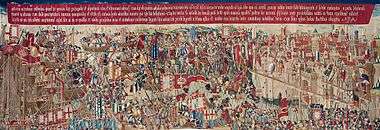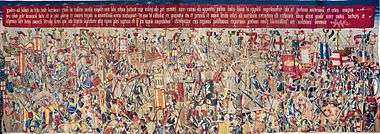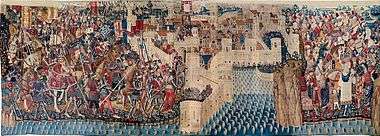Pastrana Tapestries
The so called Pastrana Tapestries (Portuguese: Tapeçarias de Pastrana) are a set of four large tapestries commissioned by king Afonso V of Portugal to celebrate the successful conquest of the Moroccan cities of Asilah and Tangiers by the Portuguese in 1471. Each measures about 11 by 4 meters (36 by 12 feet), and are made of wool and silk.[1][2][3][4]

Their manufacture has been attributed to the workshop of Passchier Grenier in Tournai, modern-day Belgium.[5] The Tapestries are remarkable for being one of the few 15th century works of weaving depicting contemporary rather than biblical or mythological episodes.[6] They feature an impressive array of detailed depictions of Gothic plate armours and weapons such as swords, crossbows, polearms, cannons, and even handcannons, that would have been innovative in the period.[7] The Tapestries have been kept at the Colegiada de Pastrana Museum in Pastrana, Spain, since 1664, though it is unknown how exactly they came to Spain.[5][1][2][3][4]
The four tapestries depict four episodes regarding the conquest of Asilah:[2][1][3]
- The Landing at Asilah
- The Siege of Asilah
- The Storming of Asilah
- The Capture of Tangier
Gallery
| Landing at Asilah | Siege of Asilah |
|---|---|
| Storming of Asilah | Takeover of Tangiers |
References
- Kennicott, Philip (September 16, 2011). "Art review: The Pastrana Tapestries at the National Gallery". Washington Post. Retrieved 12 May 2019.
- "PEM: Portuguese 15th Century Pastrana Tapestries – Exhibition". Portuguese American Journal. 9 October 2012. Retrieved 12 May 2019.
- "The Invention of Glory: Afonso V and the Pastrana Tapestries". National Gallery of Art. Retrieved 12 May 2019.
- "The Tapestries of Pastrana". European Heritage Awards / Europa Nostra Awards. April 7, 2011. Retrieved 12 May 2019.
- "Spring 2012" (PDF). At The Meadows. Meadows Museum. p. 6.
- "Spring 2012" (PDF). At The Meadows. Meadows Museum. p. 2.
- "Spring 2012" (PDF). At The Meadows. Meadows Museum. p. 3.

.jpg)

